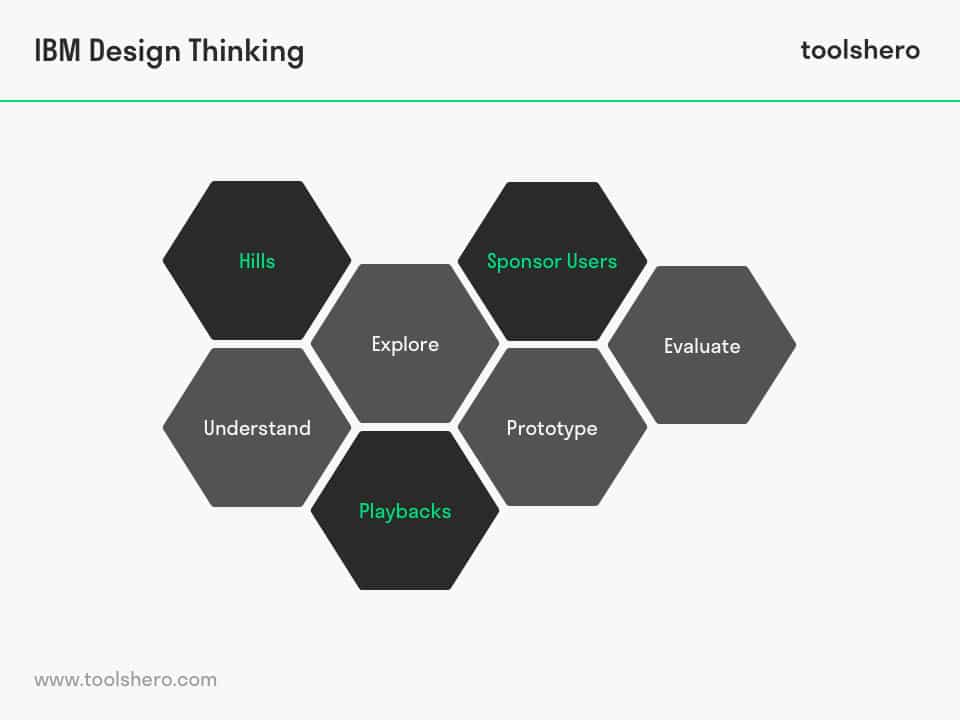IBM Design Thinking Model explained

IBM Design Thinking: this article explains IBM Design Thinking or Enterprise Design Thinking in a practical way. Next to what it is, this article also highlights the User-centred Outcome, the importance of collaborative teams, the Loop of the model and the elements. After reading it, you will understand the basics of this creativity tool. Enjoy reading!
What is IBM Design Thinking?
Design Thinking has been an iconic tool for many companies in efforts to keep pace with the growing competency in the market. The technique is designed to establish a consumer-oriented culture within an organization.
IBM global software and hardware developer has had its breakthrough in its overwhelming efforts towards establishing a fast-paced scalable IBM Design Thinking process.
This step away from the traditional Design Thinking process seeks to achieve a model more suitable for big enterprises.
It should be noted that the traditional design thinking model is more applicable to the SME’s than the big enterprises which are built on complex processes.
IBM took its leap into Design Thinking on a large scale in the year 2013. The company brought over 750 designers, 10,000 employees and numerous teams on board in its strategic process to achieve a user-based culture that is deeply embedded in the company processes.
This greater leap in Design Thinking still aims at establishing a design-driven culture embedded in the steps akin to the traditional design thinking process which involves empathizing, defining, ideating, prototyping and testing.
The IBM Design Thinking Model is built on three principles: user-centred outcome, multidisciplinary collaborative efforts and the loop process that involves iterative reinvention.
User-centred Outcome through IBM Design Thinking
IBM Design Thinking puts the user needs first on its list of priorities. This means that every decision-making is embedded in the ultimate satisfaction of users.
The model is skewed towards attaining a complete understanding and empathy for the consumer. Good Design Thinking is achieved from the client perspective.
Collaborative Teams
IBM Design Thinking process recognizes that much of the problem solving is grounded on teamwork. The principle of collaborative teams brings on board all the teams, stakeholders and users in a fast-paced action aimed at achieving user needs and expectations.
Since large companies involve complex groups rooted in different engagements, the collaborative principle aims at incorporating scalability in a model to achieve complex solutions to complex problems.
The scalability of the model is founded on three techniques: hills, playbacks, sponsor users.

Figure 1 – The IBM Design Thinking Model
Hills
Hills are designed to gather teams around a common goal embedded in human needs and desires. Grounded on an unanimous understanding of success, the teams are granted autonomy to go out on a solution finding escapade.
Playbacks
Different teams are often engaged in different projects. A playback technique is designed to bring these groups to a similar alignment directed towards achieving the project target which is ultimately centered on the user needs.
In a nutshell, playbacks are platforms of assessment and feedback that ensure everyone is aligned around a set of high-valued scenarios knit in three most iconic playback milestones: goals defining playbacks (Hills playbacks), solution defining playbacks (playback zero), progress measuring playbacks (delivery playbacks).
Sponsor Users via IBM Design Thinking
This technique involves real users from the extreme ends of the targeted user spectrum in the IBM Design Thinking process. Working with real people grounds the design experience on the reality of the user needs, unlike the imaginative approach.
This co-creation with sponsor users increases product value in a rather painless Design Thinking process.
Design Thinking Tool Box | 50+ Methods | 25+ Templates
The IBM Design Thinking loop
A loop is an iterative process, a rotational process whose end marks another beginning. The IBM Design Thinking loop represents a process of continuous reinvention that forms a road map of the company’s Design Thinking process.
The loop specifically seeks to discover user needs and endlessly prototype solutions for a better future. The loop is completed in a three-point process involving observation, reflection and making:
Observation
Take a closer look to notice the easy to miss consumer needs and verify their expectations against your ideas.
Reflect
Reflection is aimed at consolidating the knowledge acquired, developing a solid point of view and designing a solid plan.
Make
Transform ideas from the abstract into reality.
Acknowledgement and IBM Design Thinking Model
IBM Design Thinking now claims a global acknowledgement from designers, developers and institutions as well.
Higher education, in particular, is no exception. The constantly changing student demographics, rapid evolving of stakeholder demands and advancement in technology are requiring colleges to get aligned towards abiding assumptions concerning quality, time and geography.
Most educational organizations including services anticipates a future in which higher education would prefer new models embedded in organizational innovation, adaption and responsivity. Design thinking certainly offers a pathway towards shaping these new models.
This is a crucial move that will help higher learning institutions to develop internally while working in alliance with government, business and community to meet their needs.
Elements of the IBM Design Thinking
Below are the vital elements of IBM Design Thinking:
1. Personas
Seek an understanding of your target group. Collect vast amounts of information regarding their needs and expectations. This may include personal demographics, tasks, motivations, problems and frustrations.
This will reduce the gap between what you assume and the reality on the ground. This information may be obtained from sources such as interviews, surveys, direct observation and forums.
2. Empathy Maps
Having defined a representation of your target group based on the more specific user group, you need to get deeper into their thoughts, their feelings, their words and actions. This is a road map towards developing empathy which helps you identify what pains users the most.
3. As-is Scenario Maps
This is a task-oriented scenario map that documents steps taken, actions, thoughts and actions all the way through the personas’ primary task. This phase helps you develop a solid understanding of the personas’ pain points and develop deep empathy.
4. Design Ideation and Prioritizing
Creating of personas, empathy maps and As-is scenario maps help you build an understanding of the target audience. This gives you a few ideas about potential solutions.
Ideation is a brainstorming phase aimed at generating ideas.
Develop as many ideas as possible regardless of the flexibility and the ability to implement. Cluster the ideas and settle on the most promising clusters.
5. To-be Scenario Map
This scenario map reflects on the likely impact of implementing your ideas. It looks into the future state of adopting your best ideas. Capture the personas’ thoughts and feelings set in the future.
6. Wireframe Sketches
These are designed to help you develop a better sense of the anticipated outcome. These sketches are not the actual representations of the final design. Have as many alternatives as possible and obtain feedback on them from stakeholders and target audience.
7. Hypothesis-Driven Design
IBM Design Thinking seeks to create a set of measurable and testable hypothesis on whatever you design and deliver.
8. MVP Definition
Minimum Viable Product (MVP) definition is the smallest thing that you can build and deliver quickly for the purpose of testing your hypothesis and effort evaluation.
Conclusion on IBM Design Thinking
IBM Design Thinking is another step closer to consumer satisfaction. Like the traditional Design Thinking model, IBM Design Thinking model is still rooted in problem definition and brainstorming solutions.
The difference lies in the specific guiding principles which have been designed to reflect the company’s local processes grounded in the complexities of its business. The hills, playbacks and sponsor users are iconic components whose application results to a more scalable model.
This Enterprise Design Thinking has become the fastest way to generate ideas. These ideas are incorporated into the design, evaluated and tested to ultimately deliver value faster and in a more scalable framework.
It’s Your Turn
What do you think? What is your experience with IBM Design Thinking? Do you have any additions to the above? Are there tips or good experiences that you want to share with our readers?
Share your experience and knowledge in the comments box below.
More information
- Brown, B. (2018). The Total Economic Impact Of IBM’s Design Thinking Practice. Forrester Research, Inc.
- Johnson S. (2016). IBM Design Thinking Field Guide. IBM Corporation.
- Liedtka, J., King, A., & Bennett, K. (2013). Solving Problems with Design Thinking: Ten Stories of What Works. Columbia University Press.
How to cite this article:
Everett, R. (2019). IBM Design Thinking. Retrieved [insert date] from Toolshero: https://www.toolshero.com/creativity/ibm-design-thinking/
Original publication date: 02/19/2019 | Last update: 12/27/2023
Add a link to this page on your website:
<a href=”https://www.toolshero.com/creativity/ibm-design-thinking/”>Toolshero: IBM Design Thinking</a>












